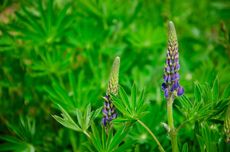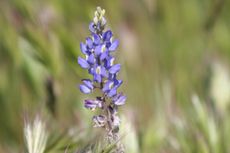Lupine Plant Diseases – Controlling Diseases Of Lupines In The Garden


Lupines, also frequently called lupins, are very attractive, easy to grow flowering plants. They are hardy in USDA zones 4 through 9, will tolerate cool and moist conditions, and produce stunning spikes of flowers in a wide range of colors. The only real drawback is the plant’s relative sensitivity to disease. Keep reading to learn more about what diseases affect lupine plants and what can be done about it.
Troubleshooting Lupine Disease Problems
There are quite a few possible diseases of lupines, some more common than others. Each should be handled accordingly: Brown spot – Leaves, stems, and seed pods can all develop brown spots and cankers and suffer premature dropping. The disease is spread through spores that live in the soil under plants. After an outbreak of brown spot, don’t plant lupines in the same location again for several years to give the spores time to die out. Anthracnose – Stems grow twisted and at strange angles, with lesions at the point of twisting. This can sometimes be treated with fungicides. Blue lupines are often the source of anthracnose, so removing and destroying any blue lupines might help. Cucumber mosaic virus – One of the most wide ranging plant diseases, this is most likely spread by aphids. Affected plants are stunted, pale, and twisted in a downward direction. There is no cure for cucumber mosaic virus, and affected lupine plants need to be destroyed. Bean yellow mosaic virus – Young plants begin to die and flop over in a recognizable candy cane shape. Leaves lose color and fall off, and the plant eventually dies. In large established plants, mosaic bean disease may only affect certain stems. The disease builds up in clover patches and is transferred to lupines by aphids. Avoid planting clover nearby and deter aphid infestations. Sclerotinia stem rot – White, cotton-like fungus grows around the stem, and parts of the plant above it wither and die. The fungus lives in the soil and mostly affects plants in wet regions. Don’t plant lupines in the same spot again for several years after this Sclerotinia stem rot occurs. Oedema – With oedema, watery lesions and blisters appear all over the plant, as the disease causes it to take in more water than it needs. Reduce your watering and increase sun exposure if possible – the problem should clear up. Powdery mildew – Gray, white, or black powder appears on the leaves of plants having powdery mildew. This is usually a result of too much or improper watering. Remove affected parts of the plant and be sure to water only the base of the plant, keeping the leaves dry.
Gardening tips, videos, info and more delivered right to your inbox!
Sign up for the Gardening Know How newsletter today and receive a free download of our most popular eBook "How to Grow Delicious Tomatoes."

The only child of a horticulturist and an English teacher, Liz Baessler was destined to become a gardening editor. She has been with Gardening Know how since 2015, and a Senior Editor since 2020. She holds a BA in English from Brandeis University and an MA in English from the University of Geneva, Switzerland. After years of gardening in containers and community garden plots, she finally has a backyard of her own, which she is systematically filling with vegetables and flowers.
-
 Urban Composting Guide: How To Compost In The Middle Of The City
Urban Composting Guide: How To Compost In The Middle Of The CityUrban composting does not have to be daunting. You can compost in the city, and maybe even try some urban worm composting!
By Mary Ellen Ellis
-
 Shrub Diseases And Pests To Watch Out For
Shrub Diseases And Pests To Watch Out ForShrub diseases and pests can be challenging. Learn how to recognize and eradicate them before they can present a danger to your plants.
By Susan Albert
-
 Arroyo Lupine Information: Learn How To Grow An Arroyo Lupine Plant
Arroyo Lupine Information: Learn How To Grow An Arroyo Lupine PlantArroyo lupine plants are the welcome signs of spring on the rocky slopes and grasslands of the Western United States. Pollinators are highly attracted to these plants and the seeds sustain small wildlife critters. For more arroyo lupine information, click here.
By Mary H. Dyer
-
 Desert Lupine Plant Care – How To Grow Desert Lupine Plants
Desert Lupine Plant Care – How To Grow Desert Lupine PlantsDesert lupine is a wildflower that grows across the southwestern United States and parts of northern Mexico. This nectar-rich desert wildflower is highly attractive to a number of pollinators, including honeybees and bumblebees. Learn more here.
By Mary H. Dyer
-
 Bigleaf Lupine Care: What Is A Bigleaf Lupine Plant
Bigleaf Lupine Care: What Is A Bigleaf Lupine PlantBigleaf lupine is a big, tough, flowering plant that is sometimes grown as an ornamental but is also often battled as a weed. Click on the following article to learn more about growing bigleaf lupines and when bigleaf lupine control is the best option.
By Liz Baessler
-
 Growing Blue Bonnets - When To Plant Blue Bonnets In The Garden
Growing Blue Bonnets - When To Plant Blue Bonnets In The GardenGrowing blue bonnets adds an interesting shade of color to the spring landscape. Texas blue bonnets are easy to grow and you can find tips on how to grow these plants in this article.
By Becca Badgett
-
 Planting Lupine Flowers - How To Grow Lupines
Planting Lupine Flowers - How To Grow LupinesLupines are attractive and spiky, reaching 1 to 4 feet (30 to 120 cm.) in height and add color and texture to the back of a flowerbed. This article has information on planting lupines in this garden.
By Becca Badgett